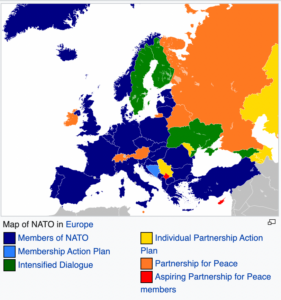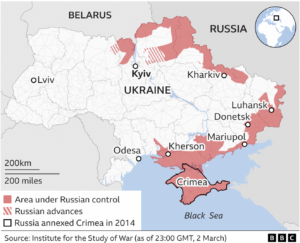This week’s back-to-back G7 and NATO summits mark a watershed in history as the world unites against Vladimir Putin.
For decades, he has fomented violence around the world and built pipelines, and illicit relationships, in Europe in order to hold the continent hostage economically. Germany and the European Union ignored warnings that reliance on Russia posed a security threat.
They also did nothing to stop Russia’s first invasion of Ukraine in 2014 and have relied on the country – Europe’s biggest but poorest nation-state – to defend Europe’s eastern boundary by itself for eight years, at a cost of 7% of its GDP per year and loss of 15,000 lives and the displacement of 1.2 million refugees.
Despite this, NATO has refused Ukraine membership which allowed Putin to fully invade in February. But finally, the Great Procrastination over Putin has ended and the civilized world unites to bring about the end of the beginning of Putin’s World War III.

NATO’s total reach beyond its current membership of 32 which now includes Sweden and Finland and Ukraine as its proxy.
The G7 met first. Its seven members own half the world’s wealth, nearly half its GDP and 10% of its population and its role is to protect global economic stability. NATO’s 30 members and affiliated countries are tasked with military protection.
This week, both pledged ongoing support for Ukraine and announced major initiatives to stop Putin. Russia reacted with contempt but there’s no question that this unprecedented military and monetary alliance will eventually bring him to his knees, hopefully without bringing the world to the brink of nuclear war.
Announcements made this week are also historic: Europe is assuming more responsibility for its own defence (long overdue), NATO expanded and its members have pivoted to Asia in order to impede Russia’s sidekick China. Commitments were enormous. The G7 pledged hundreds of billions to help Ukraine for “as long as it takes” [to defeat Putin].
It enlisted other key nations to oppose Russia in a statement that read: “We, the leaders of the Group of Seven…were joined by the leaders of Argentina, India, Indonesia, Senegal, and South Africa, as well as Ukraine. We reemphasize our condemnation of Russia’s illegal and unjustifiable war of aggression against Ukraine.”
Next NATO announced a 10-year plan to enlarge and expand its collective military capability, and support Ukraine, in the following ways: More weapons to Ukraine; expansion by allowing Finland and Sweden to join (in defiance of Russia’s threat this would result in escalation); and a dramatic increase in military mobilization in the Eastern flank of Europe.
The number of its troops placed permanently on “high alert” will grow from 40,000 to 300,000 in the East. Response from Russia took place pre-emptively and just as the G7 convened Moscow launched a series of missile attacks against Ukraine targeting civilians in several cities. One prominent Russian State television host warned that Russia was using only 18% of its army in Ukraine and was ready for “a direct confrontation” with NATO if necessary. More officially, Russia spokesmen said the NATO expansion was “destabilizing”, “posed another threat to Russia” and that Russia will likely place hypersonic missiles along its borders with EU countries.

Military capability between NATO and its allies versus Russia and China Russian atrocities have resulted in revulsion and this call to arms. Ukraine’s armed forces now total one million men and women and armaments continue to flood into the country. Germany has agreed to double the size of its military (to meet its 2% NATO commitment for the first time) and other countries promise to do the same.
Collectively, NATO’s military budgets are already 20 times’ Russia’s and its manpower advantage overwhelming, not to mention the wealth of the economies and military industries that underpin these armed forces. There are also three nuclear powers in NATO – the United States, Britain and France. NATO’s shift to China is due to its bellicosity in Asia but also its aggressive incursion into Europe, through building and ownership of critical infrastructure such as ports, bridges, and roads and airfields.
Members now realize that control over such assets by unfriendly nations represent security risks, just as Putin’s energy pipelines did. A new emphasis on Beijing is why this week’s NATO summit was also attended by India, Japan, Australia, New Zealand and South Korea for the first time. Unfortunately, there should be no delusions that the G7’s generosity and reach plus NATO’s new show of strength will deter Russia or end the conflict, any more than has its nuclear prowess.

Ukraine’s President Volodymyr Zelensky addressed both summits, asking for weaponry and financial assistance to push Russia out of his country, but also asked: “Europe is embarking on a 10-year plan to protect itself. In four months of war, we have been subjected to Cruise missiles, torture, the murder of children, the rape of women… Ukraine doesn’t have ten more years. Are you sure you have them?”

The reality is that NATO has been timid and Europeans have buried their heads in the sand for decades. The North Atlantic Treaty Organization was founded in 1949 by North American, European, and Nordic states who pledged mutual military assistance in the event of an attack from the Soviet Union.
Fortunately, the Soviet Union never attacked Europe because the country fell apart and its Baltic, Central and Eastern European colonies declared independence after 1989.
But, along the way NATO has made serious missteps such as the murderous saturation bombing of Serbia and other major lapses. For years, NATO summits have consisted of a star-studded list of leaders from democracies in North America and Europe and a room full of military brass dripping with epaulets, medals, and excuses.
Despite good intentions and more military firepower collectively than the world has ever known, the reality is that NATO has let Putin get away with literally tens of thousands of audacious “acts of war” against its members and the continent for years. He “invaded” four European countries – Ukraine and Georgia and Moldova and Eurasia’s Azerbaijan – and unleashed “hybrid war” against the rest.
These included cyberattacks, information warfare, assassinations, bombings, bioweapon attacks, terrorist acts, social media sabotage, disinformation campaigns, influence peddling, espionage, election meddling, and bribery. All represented grave security threats and, in the case of Ukraine, Putin’s “frozen conflict” in the Donbas turned into a full-scale war as will the others unless he’s removed.
Frozen conflicts as of 2021 caused by Russia that can turn into wars The frozen conflict that turned into the 2022 war against all of Ukraine NATO also dropped the ball in 2019 when people in Belarus began protesting for democracy at the same time as Putin was pressuring its dictator, Aleksandr Lukashenko, to merge with Russia and place military bases along its border with European Union nations.
Lukashenko reached out to NATO and the EU but Putin moved quickly and cut off the country’s fuel supplies and sent in Russian operatives to subjugate the populace.
Now the country is run by Putin and is a de facto province of Russia and staging ground for attacks against Ukraine and nuclear ones against Europe. Another major mistake was to deny Ukraine and Georgia major Non-NATO Ally Status, as was done with 17 countries including Australia, Israel, and South Korea.
In recent years, the NATO member pushing hardest for this was Turkey, upset about Russia’s takeover of Crimea in 2014 and the fact its naval forces amassed on the Black Sea to harass and eventually invade Ukraine. Turkey signed a mutual defence treaty with Kyiv and, in retaliation, Putin banned all Russian tourism and much of its trade with Turkey.
Arguably, if NATO had heeded Turkey and let Ukraine in as an associate, Ukraine would never have been invaded. Now the poor country is Europe’s bulwark against a monstrous regime in Moscow.
What’s notable this week is that the G7 and NATO are crossing Putin’s “red lines” without direct retaliation by helping Ukraine. President Joe Biden also announced more significant weapons allocations this week of 18 warships, battlefield firepower that will outdistance Russia’s guns as well as a system to protect its skies from missile attacks. Such assistance by the civilized world represents the strongest rebuke — and bad omen — for the little dictator in the Kremlin.
The world’s support has also been inspired by the heroic and resolute Ukrainian people. Despite the egregious attacks on a shopping center and residences that were meant to send a message to the West this week to back off, a new poll, taken as bodies were being removed from Russia’s murderous bombings, showed that 89% of Ukrainians reject ceding land to reach peace with Russia. They will never, ever give up, and neither should the rest of us.
Diane Francis Newsletter on America and the World 30-day free trial at https://dianefrancis.substack.com/about
The views expressed in this article are those of the author and not necessarily those of the Kyiv Post.
